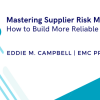During the COVID-19 pandemic, companies have had to navigate unprecedented supply and demand chain challenges. In fact, industries were seeing increasing instability in this area prior to the pandemic’s onset. Susan Lund, a partner at the McKinsey Global Institute, says even before COVID research conducted revealed that, on average, companies could expect to see a disruption to their production lines of one to two months occurring every three-and-a-half to four years.
Organizations are needing to revamp their sourcing strategies to ensure agility, resiliency and stability, and a measured approach that reduces organizational risk. This requires automation, visibility, control and the consistent application of best-in-class source-to-pay processes.
Sourcing New Qualified Suppliers
Companies are responding with fresh procurement strategies to source new qualified suppliers. These include online auctions and sourcing events, dual sourcing/multiple sourcing strategies and leveraging procurement marketplaces such as Amazon Business.
To increase the pace of sourcing and lighten the administrative workload, cloud-based supplier portals can be used to support request for proposals/quotes and online auctions.
From a procurement perspective, a supplier offering favorable pricing may seem attractive. However, organizations must be cautious to vet suppliers as the present pandemic is imposing significant business challenges. Conduct thorough due diligence to ensure your supplier partner can go the distance and deliver while withstanding disruptions (such as additional lockdowns).
Capabilities within supplier portals can help companies to qualify/vet and survey potential business partners to assess suppliers’ ability to comply with specified sourcing criteria. This streamlines the process of identifying new qualified suppliers to participate in sourcing events as well as making the process open to existing approved suppliers.
Integration to external ecosystem partners to access procurement marketplaces such as Amazon, supplier insights through Dun and Bradstreet, and electronic signature validation through DocuSign empower the organization to streamline informed decision-making.
Streamlining Supplier Onboarding and Contracting
Once suppliers are selected, a supplier portal can also help speed supplier onboarding and contract processing. Visibility in the source to contract award process brings increased utility to organizations practicing dual sourcing and/or multiple supplier sourcing. Additionally, organizations gain newfound capabilities to create and manage contracts with greater efficiency, visibility and audit control.
A communication and risk management plan should be implemented for each new supplier. The potential risks of the relationship should be identified and then mitigated with sufficient compliance measures. These arrangements are then formalized with the signed contract. In the past, this was an enormously time-consuming, manual, paper-based process. Today’s technology can auto-generate contracts based on pre-prepared information plugged into the system beforehand and from the RFP previously submitted to ensure supplier information accuracy.
Ensuring Performance Management Controls
Organizations need to understand the performance of their supplier performance base, which has morphed quickly due to COVID-19, so they can ensure they standardize on the best performing suppliers moving forward.
Again, technology can play a role in supporting this vital activity by helping organizations establish milestones, enforce terms and conditions of the supplier relationship, and track metrics for supplier performance management.
Key performance indicators (KPIs) and objectives should be set and tracked to hold suppliers to account, with agreed upon checkpoints in place for service level delivery and performance against the previously agreed upon service levels and KPIs.
Ongoing supplier performance monitoring should include validation of:
- Receipt of timely deliveries of goods
- Product quality
- Stock availability
- Satisfactory customer service and communications
Invoice Set Up
Next, invoicing must be set up. Invoice automation can provide benefits in cycle time reduction and reducing late payments, especially if the new contract generates high invoice volumes. eInvoicing and 3-way PO matching can reduce fraud and support “touchless” processing to reduce accounts payable costs.
In some instances (and per contractual agreements), organizations can gain early pay discounts. These are to the advantage of both the supplier and the payer, but organizations must be able to process and pay invoices quickly to support this strategy.
Additionally, tracking cost savings secured with any new supplier should be communicated back to the wider business to showcase benefits to the bottom line.
Weathering Whatever Is Next
The COVID-19 pandemic may have been a black swan event, but it has exposed inherent risks and instabilities in the supply chain. It has put the need for procure-to-pay strategies to improve resilience and agility on the forefront of the C-suite agenda.
Today’s digital supply management platforms and tools improve operational visibility and streamline decision-making within an organization and with suppliers. This enables organizations to revamp their supply chains to successfully weather whatever is next.









